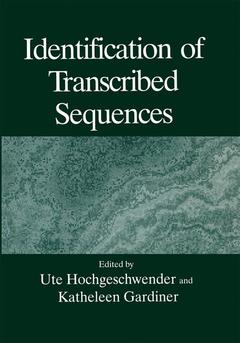Identification of Transcribed Sequences, Softcover reprint of the original 1st ed. 1994
Langue : Anglais
Coordonnateurs : Gardiner K., Hochgeschwender U.

The Human Genome Project, an endeavor to map and sequence the entire human genome, has been in existence for almost seven years. One result of this effort has been the development of increasingly detailed genetic and physical maps spanning large regions of virtually every chromosome. Paralleling this has been the increasingly high resolution mapping of many &wnetic diseases. Together, these developments have facilitated the isolation of specific disease genes and are now motivating the construction of comprehensive transcriptional maps. This latter endeavor represents a new facet of the genome project, and as such requires the recognition and solution of a new set of problems, with the attendant development and application of a new set of techniques. The First International Workshop on the Identification of Transcribed Sequences in the Human Genome was held in 1991 and was attended by 23 investigators. Discussions at this meeting were largely devoted to defining the magnitude of the problem and describing the available techniques. A small number of laboratories reported the development of new techniques (at that time, for example, exon trapping, cDNA hybrid selection, direct cDNA screening, use of splice junction conserved sequences,etc.), but data were too limited to permit comparisons of their relative efficiencies.
From Genomic DNA to Transcribed Sequences: Classical Approaches: Use of cDNA Selection and Evolutionarily Conserved Sequences to Isolate Transcribed Sequences from Region Xp11.21; E.N. Burright, et al. Identification of cDNAs by Direct Hybridization Using Cosmid Probes; G.G. Lennon, K. Lieuallen. Hybridization Based Approaches: Hybridization Selection: Towards a Transcriptional Map of Human Chromosome 21; K. Gardiner, et al. Variations on Hybridization Selection. Direct cDNA Screening. Exon Trapping: An Exon Trapping System Providing Size Selection of Spliced Clones and Facilitating Direct Cloning; N.A. Datson, et al. Computer Based Approaches: Shallow Shotgun Sequencing as a Strategy for Finding Coding Exons; J.M. Claverie. From Transcribed Sequences To Genomic Localization: Generating and Sequencing cDNAs: Requirements in Screening cDNA Libraries for New Genes and Solutions Offered by SBH Technology; R. Drmanac, et al. Mapping cDNAs: Mapping cDNAs by Hybridization to Gridded Arrays of DNA from YAC Clones; D.R. Moir, et al. 19 additional articles. Index.
Date de parution : 10-2012
Ouvrage de 304 p.
17.8x25.4 cm
Disponible chez l'éditeur (délai d'approvisionnement : 15 jours).
Prix indicatif 52,74 €
Ajouter au panierThèmes d’Identification of Transcribed Sequences :
Mots-clés :
Chromosom; DNA; YAC; cloning; genes; hybridization; transcription
© 2024 LAVOISIER S.A.S.



